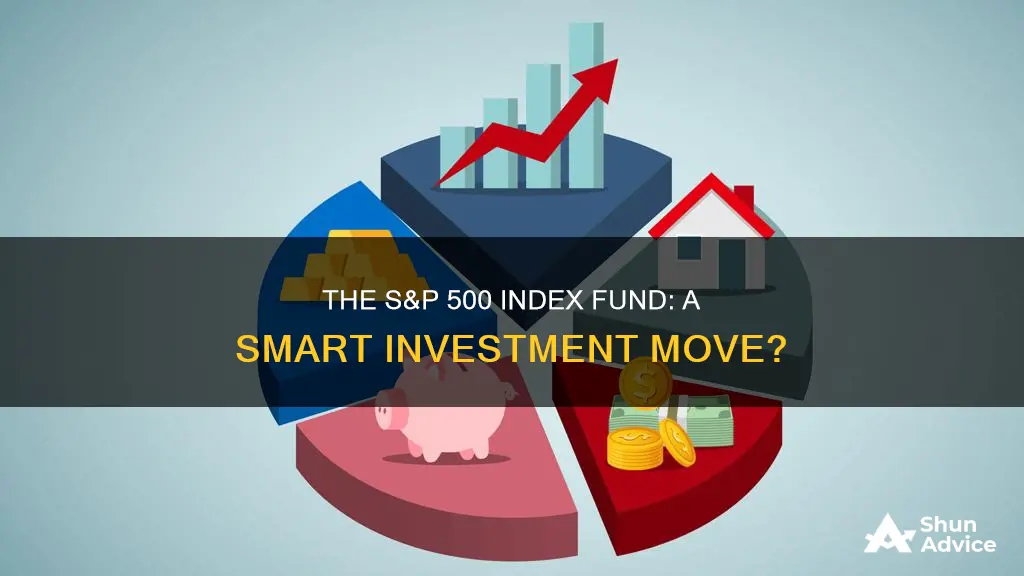
The S&P 500 index is a stock market index that tracks the performance of 500 of the largest U.S. public companies by market capitalization. It is considered a bellwether for the American stock market and has returned an average of about 10% annually over time. Index funds are a type of investment fund that is based on an index and aims to mimic its composition. An S&P 500 index fund allows investors to gain exposure to a diverse range of stocks from large U.S. companies, offering broad market access at a low cost. While investing in an S&P 500 index fund can provide potential benefits such as diversification and low fees, it is important to consider the risks and weigh them against your financial goals and risk tolerance.
| Characteristics | Values |
|---|---|
| Type of investment fund | Mutual fund or ETF |
| Investment fund theme | Large companies in the U.S. |
| Investment fund composition | 500 leading U.S. companies |
| Investment fund performance | 10% per year on average, before inflation |
| Investment fund fees | Expense ratio of 0.03% to 0.10% |
| Investment fund diversification | Broadly diversified portfolio |
| Investment fund purchase | Bought in taxable brokerage account, 401(k), IRA, HSA, or 529 plan |
What You'll Learn

What is the S&P 500?
The S&P 500, or Standard and Poor's 500, is a stock market index that tracks the performance of 500 of the largest U.S. public companies by market capitalization, or the total value of all their outstanding shares. The index was launched in 1957 by the credit rating agency Standard and Poor's and is regarded as one of the best gauges of prominent American equities' performance and the overall stock market.
The S&P 500 includes leading U.S. companies, although the number of companies may fluctuate. As of May 2024, there were 503 constituents in the index, with an estimated total market capitalization of $43 trillion. The index represents approximately 80% of available U.S. market capitalization and features companies from various sectors, including Information Technology, Financials, and Healthcare.
The S&P 500 uses a market-cap-weighting method, which gives a higher percentage allocation to companies with the largest market capitalizations. The index is calculated by taking the company's market cap and dividing it by the total market cap of the index.
While individuals cannot invest directly in the S&P 500, they can invest in funds that track the index, such as index funds or exchange-traded funds (ETFs). These funds provide investors with broad exposure to the constituent stocks in the S&P 500 and are considered a good way to diversify an investment portfolio.
Hedge Funds: Banking's Exclusive Investment Club
You may want to see also

Advantages and disadvantages of investing in the S&P 500
Advantages
- Diversification: The S&P 500 index provides instant diversification by encompassing 500 large-cap U.S. stocks from a wide range of sectors, including technology, healthcare, finance, and consumer goods. This diversification helps reduce the risk associated with investing in individual stocks.
- Long-term growth: Historically, the S&P 500 has shown strong long-term growth potential, outperforming many other investment options. While short-term market fluctuations may occur, the S&P 500’s underlying trend has been upward, driven by the growth of the U.S. economy.
- Accessibility: The S&P 500 is accessible to a wide range of investors through index funds, exchange-traded funds (ETFs), or mutual funds, making it suitable for both individual investors and those with limited investment knowledge. Many brokerage platforms also offer low-cost options.
- Professional management: The S&P 500 is managed by a committee that ensures the index accurately represents the U.S. large-cap stock market. This committee regularly reviews and adjusts the index constituents, providing investors with confidence in the index’s composition.
- Exposure to dynamic companies: The S&P 500 includes some of the world's most dynamic companies, such as Apple, Amazon, Microsoft, and Johnson & Johnson.
- Consistent long-term returns: The S&P 500 has consistently performed well over the long term, although returns in any single year can vary widely.
- No intricate analysis required: Investing in the S&P 500 through an ETF or index fund means investors do not need to analyze or pick stocks.
- Can serve as a core holding: S&P 500 index funds and ETFs are liquid and trade with tight bid-ask spreads, making them ideal as core holdings for most investment portfolios.
Disadvantages
- Market volatility: The S&P 500 is not immune to market volatility and can experience significant declines during periods of market downturns. It is crucial to have a long-term investment horizon and be able to weather short-term fluctuations.
- Lack of individual stock selection: Investing in the S&P 500 means giving up control over individual stock selection, potentially missing out on gains from stocks that outperform the broader market. Investors seeking more control over their portfolio may prefer a strategy that includes individual stock picks.
- Concentration in U.S. stocks: The S&P 500 is heavily weighted towards U.S.-based companies, resulting in limited exposure to international markets and reducing the diversification benefits of global investments.
- Inclusion of underperforming stocks: Underperforming stocks may remain in the index for a certain period, impacting the overall performance during those times.
- Limited exposure to small and mid-cap stocks: The S&P 500 is dominated by large-cap companies, with its biggest constituents accounting for about one-third of the index. This means it has limited exposure to small-cap and mid-cap stocks, which may have higher growth potential.
- Inherent risks of equity investing: The S&P 500 carries the risks inherent in equity investing, such as volatility and downside risk, which may be challenging for newer investors to tolerate.
Mutual Fund SIPs: Invest Now or Later?
You may want to see also

How to invest in the S&P 500
The S&P 500 is a stock market index composed of 500 large U.S. public companies, and it is often considered a proxy for the overall health of the U.S. stock market. While you cannot directly invest in the S&P 500 index itself, there are a few ways to gain exposure to the index:
- Buying individual stocks: You can purchase stocks of companies that are included in the S&P 500. However, this approach can be tedious and expensive, as it requires buying stocks from each of the 500 companies.
- Investing in an S&P 500 index fund: An index fund is a type of investment fund (either a mutual fund or an ETF) that aims to replicate the performance of the S&P 500 index. Index funds offer broad diversification and are considered less risky than purchasing individual stocks directly. When selecting an index fund, look for funds with low expense ratios and no sales load.
- Investing in an S&P 500 ETF: ETFs (Exchange-Traded Funds) are similar to index funds but trade like stocks, with values that fluctuate throughout the day. ETFs offer the advantage of being able to buy and sell throughout the trading day, whereas index funds can only be bought and sold at the end of each trading day. When selecting an S&P 500 ETF, consider factors such as expense ratio, liquidity, and dividend yield.
To invest in the S&P 500, follow these steps:
- Find an S&P 500 index fund or ETF: Compare different funds based on their expense ratios, sales load, and other criteria.
- Open an investing account: You will need an investment account such as a brokerage account, IRA, or 401(k) to purchase the index fund or ETF. Consider factors such as fund selection, convenience, trading costs, and commission-free options when choosing a broker.
- Determine your investment amount: Decide how much you can afford to invest and transfer that amount to your brokerage account. Consider setting up regular contributions to your investment account to take advantage of dollar-cost averaging.
- Purchase the index fund or ETF: Go to your broker's website and place a trade for the desired number of shares or dollar amount of the fund. Many brokers also allow you to set up recurring purchases on a schedule.
Keep in mind that investing in the S&P 500 should be part of a broader investment strategy. Diversification is important, so consider including other types of investments in your portfolio, such as small- and mid-cap companies, international stocks, and bonds.
Strategies for Investing in George Soros' Hedge Funds
You may want to see also

S&P 500 index funds vs. ETFs
Index funds and ETFs are two different investment vehicles that can be used to gain exposure to the S&P 500 index. Here are some key differences between the two:
Trading Mechanism
Index funds can only be bought and sold at the end of the trading day, based on the fund's net asset value (NAV). ETFs, on the other hand, trade throughout the day on a stock exchange, just like stocks, and their price fluctuates based on supply and demand. This makes ETFs more suitable for active investors who want to buy and sell throughout the day.
Minimum Investment
Index funds often have a minimum investment requirement, which can be a barrier for some investors. In contrast, ETFs typically do not have minimums, as you can purchase as little as one share.
Taxation
ETFs tend to be more tax-efficient than index funds because of their structure. ETFs generally use an "in-kind" creation and redemption process, which minimises capital gains distributions that would otherwise trigger tax events. On the other hand, index funds may generate capital gains when the fund manager has to sell holdings to meet redemptions, potentially leading to a tax liability for investors.
Fees and Expenses
Index funds and ETFs have different types of fees. ETFs may incur trading commissions or flat fees each time you buy or sell, depending on your broker. Index funds, on the other hand, may charge a commission and/or a load fee for buying and selling. Load fees can be a flat fee or a percentage of the transaction. However, there are also no-load index funds that do not charge this fee. In terms of expense ratios, index funds tend to have lower expense ratios than ETFs.
Liquidity
Since index funds are bought and sold at the end of the trading day, they may have lower liquidity compared to ETFs.
Diversification and Risk
Both index funds and ETFs provide diversification by holding a basket of securities, which helps to reduce risk. However, the level of diversification may vary depending on the specific fund and the index it tracks.
Returns
The returns of ETFs and index funds tend to be similar when they track the same index, as both aim to replicate the performance of their benchmark. Any differences in returns are usually minimal and often due to tracking error, expenses, and how dividends are handled.
Suitability for Long-Term Investing
Index mutual funds could be more suitable for long-term investors who are not looking to buy or sell frequently. Long-term investors can also benefit from the automatic purchase plans offered by some index fund managers, which are not available with ETFs.
Tax Efficiency
ETFs may be more tax-efficient than index funds, especially for investors in higher tax brackets, as they do not trigger capital gains taxes when other investors cash out.
Accessibility
ETFs are usually not available as an investment option in workplace retirement plans like 401(k)s. Index funds and other mutual funds are more commonly offered in such plans.
In summary, both S&P 500 index funds and ETFs offer investors a way to gain exposure to the performance of the S&P 500 index. The choice between the two depends on various factors, including investment goals, investment horizon, tax considerations, and desired level of flexibility and liquidity.
Launching an Investment Fund: Training for Beginners
You may want to see also

Long-term investment potential
The S&P 500 Index is a stock market index that tracks the performance of 500 of the largest U.S. public companies by market capitalization. It is considered a bellwether for the American stock market and a gauge of the U.S. economy.
The S&P 500 has returned an average of about 10% per year over time, making it an attractive investment option for those seeking long-term returns. Investing in an S&P 500 index fund offers broad diversification, low costs, and solid historical performance.
Diversification
By investing in an S&P 500 index fund, you gain exposure to a diverse range of large U.S. companies across different sectors. This diversification helps to lower your risk, as the poor performance of one company will not significantly impact your overall investment.
Low Costs
S&P 500 index funds tend to have low expense ratios, making them a cost-effective investment option. These funds are passively managed, which means they aim to replicate the performance of the index rather than actively trying to outperform it. As a result, the fees charged by fund managers are typically lower than those of actively managed funds.
Historical Performance
The S&P 500 has a strong track record of generating consistent long-term returns. While past performance is not a guarantee of future results, the index has historically averaged an annual return of about 10%. This performance is often used as a benchmark to evaluate the success of active traders or stock-picking investors.
Buy-and-Hold Strategy
The S&P 500 is well-suited to a buy-and-hold investment strategy. By investing for the long term, you can take advantage of dollar-cost averaging, which can help reduce risk and increase returns. Additionally, the S&P 500 tends to recover from major downturns, making it a relatively stable investment over longer periods.
Automatic Rebalancing
The S&P 500 index is automatically adjusted to reflect the performance of its constituent companies. If a company is failing, it will be sold off, and emerging companies will be added. This automatic rebalancing ensures that your investment remains up-to-date with the latest market trends without requiring active management on your part.
Tax-Advantaged Accounts
You can invest in the S&P 500 through tax-advantaged accounts such as 401(k)s, IRAs, HSAs, or 529 plans. These accounts offer tax benefits that can further enhance the long-term investment potential of the S&P 500.
In summary, the S&P 500 index fund is a solid option for long-term investors seeking broad market exposure, diversification, and low costs. However, it's important to remember that investing in the stock market carries inherent risks, and past performance does not guarantee future results. Therefore, it is generally not advisable to invest all your savings in a single fund, as it is important to build a diversified portfolio that includes other asset classes and investment strategies.
Target Date Funds: Smart, Simple, and Stress-Free Investing
You may want to see also
Frequently asked questions
The S&P 500 is a stock market index that tracks the performance of 500 of the largest U.S. public companies by market capitalization. It is considered a bellwether for the American stock market and a benchmark for investors.
Investing in an S&P 500 index fund offers broad diversification across a wide range of large U.S. companies. It provides exposure to some of the world's most dynamic companies and has consistently delivered strong long-term returns. Additionally, S&P 500 index funds tend to have low expense ratios, making them a cost-effective investment option.
You can invest in an S&P 500 index fund through a taxable brokerage account, a 401(k), an IRA, an HSA, or a 529 plan. When selecting a fund, consider factors such as the expense ratio, sales load, dividend yield, and inception date. You can set up regular contributions to the fund through your chosen account.
While S&P 500 index funds offer diversification, they are dominated by large-cap companies, limiting exposure to small- and mid-cap stocks with potentially higher growth rates. The index also carries the inherent risks of equity investing, including volatility and downside risk. Additionally, the S&P 500 only includes U.S. companies, so it may not provide adequate international diversification.







